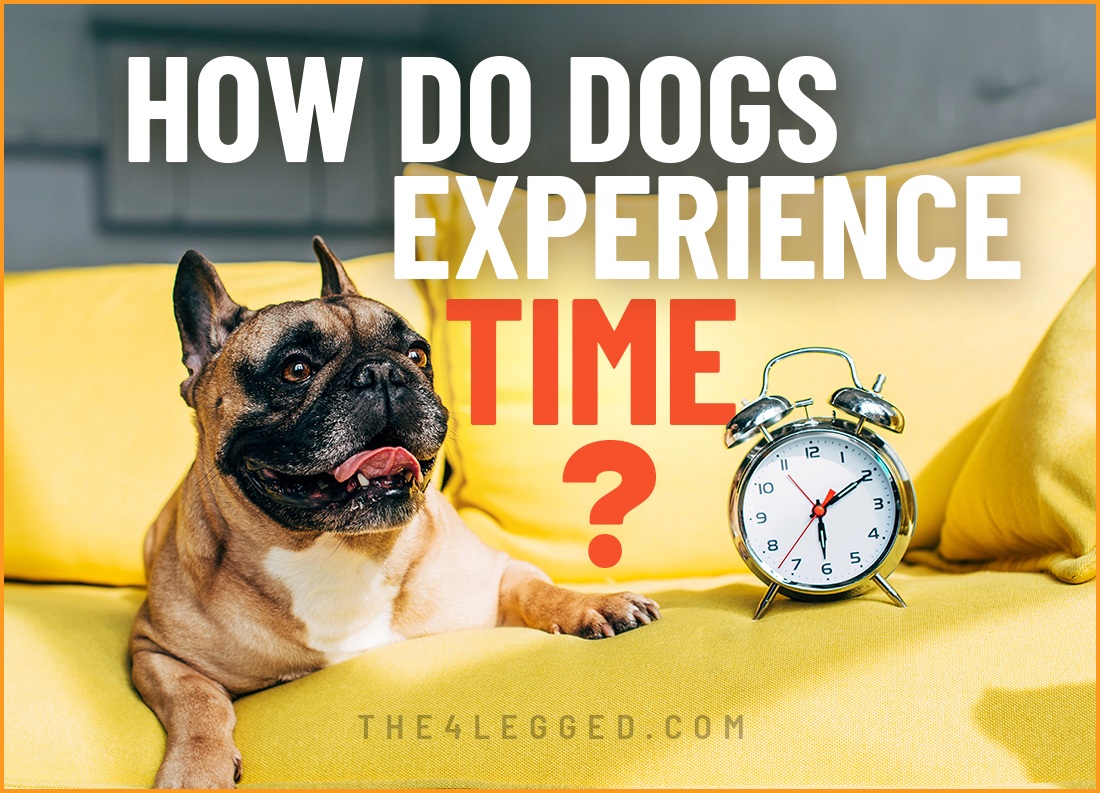Ever ponder how your dog always seems to know when it’s time for food or when you’re going to enter the house? It’s not because they can read a clock—so how do dogs experience time?
Unlike humans, dogs don’t perceive time in hours or minutes. Instead, they rely on familiar routines, subtle changes in their environment, and their powerful senses to make sense of the day. Their understanding of time is shaped by instinct, repetition, and biological rhythms—not numbers on a watch.
In this article, we’ll explore how dogs experience time, what influences their internal clock, and how this impacts their behavior, emotions, and connection with their human companions.
Key Takeaways
- Dogs perceive time through routines and environmental cues, rather than precise measurements like humans.
- Circadian rhythms and heightened senses, especially smell, play crucial roles in how dogs gauge time and predict daily events.
- Maintaining consistent routines can help alleviate dogs’ anxiety related to separation and provide them with a sense of security.
Dogs’ Perception of Time
Unlike humans, dogs do not perceive time in an abstract manner. They lack a precise understanding of hours and minutes and do not experience time in the same way we do. Instead, their perception of time is rooted in changes in their body and environment. Dogs rely on routines, daily patterns, and associative learning to understand time, which contrasts with the human concept of time. This reflects a dog’s sense of time and how animals, including primates, rodents, and birds, perceive time differently based on their species-specific behaviors and biological rhythms.
Dogs’ metabolism plays a significant role in their dog’s perception of time. Their internal clock is influenced by their metabolic rate, which causes them to experience time differently than humans. For example, most dogs anticipate meal times through their body’s hunger signals and routine, rather than a specific hour on the clock. This highlights a dog’s ability to perceive time through internal cues, such as circadian rhythms and biological processes.
Routines and daily patterns are crucial for a dog’s sense of time. Dogs link behaviors with specific activities to anticipate events like dinner time or their owners’ return. Associative learning helps dogs grasp time intervals without needing an alarm clock or precise timekeeping. The dog’s perception of time is based on these routines and sensory cues, and they do not have the same concept of time as humans, relying instead on patterns and learned associations.
While dogs can anticipate daily events and changes, their sophisticated understanding of time is rooted in their ability to use routines, sensory cues, and associative learning, rather than a human-like awareness of abstract time.
The Role of Circadian Rhythms in Dogs
Circadian rhythms are internal biological clocks that help dogs predict daily events such as feeding and sleeping. The circadian rhythm is the internal process that governs a dog’s daily physiological processes, including sleep, wakefulness, feeding, and activity patterns. These rhythms regulate dogs’ daily activities and sleep cycles, adapting to their environments and routines. Much like humans, dogs’ biological clock helps synchronize various metabolic functions with environmental cycles.
Physiological changes, such as hunger and sleepiness, signal to dogs when to expect certain events throughout the day. For example, increased morning hunger or sleepiness at night signals their internal clocks are in sync with daily routines. These changes are influenced by hormone levels, which signal times to engage in activities like eating or sleeping. The internal biological clock is the mechanism that regulates these physiological and behavioral changes over a 24-hour cycle.
Dogs’ circadian rhythms are also influenced by light exposure and feeding patterns. The body’s circadian system operates similarly to humans, adapting to light and darkness cycles. Over the course of a day, these physiological and behavioral processes help dogs interpret the passing of time through biological cues and scent changes. This adaptation helps dogs adjust their sleep-wake cycles and feeding patterns, ensuring they remain in harmony with their environment and routines.
Episodic Memory in Dogs
Episodic memory in dogs is akin to an associative memory that helps them recall past events through their senses. Dogs utilize their heightened sense of smell to remember specific experiences, which aids their understanding of time intervals. For example, the smell of a familiar scent can trigger memories of a specific event, helping dogs recognize patterns in their daily routines.
Dogs can recognize patterns in their daily activities, which further aids their understanding of time. This episodic memory allows dogs to connect certain behaviors or events with specific times of the day. For instance, a dog may associate the sound of the front door opening with their owner coming home, anticipating the moment with excitement. Some dogs can even remember events that happened days or even weeks ago, showing their ability to perceive and recall longer periods of time.
The ability to remember and recognize scents plays a crucial role in dogs’ time perception. However, this dog’s ability can vary significantly based on a dog’s breed, age, and personality traits. Some breeds may have a stronger sense of smell and memory recall, while others may rely more on visual or auditory cues.
How Dogs Use Their Senses to Gauge Time
Dogs’ heightened senses, particularly their sense of smell and changes in light, play a vital role in how they perceive time, demonstrating good sense in tracking the passage of time. A dog’s sense allows them to rely on their natural abilities and routines to interpret time through olfactory cues and environmental changes. The strength of a familiar scent helps dogs track the passage of time, indicating when their owner might return. For instance, as a person’s scent fades over time, a dog can gauge how long their owner has been gone, showcasing a dog’s sense of time.
Olfactory memory is a powerful tool for dogs. The intensity of scents changes when an owner is away, enabling dogs to sense a long absence. A scent getting stronger in the air can signal to a dog that someone may arrive soon. This ability enables dogs to predict events using their sense of smell. A dog’s sense of time is closely linked to their ability to detect these subtle scent changes throughout the day.
Environmental cues like changes in light and feeding patterns also influence dogs’ time perception. Dogs’ circadian rhythms are affected by light exposure, which helps them adapt their sleep-wake cycles and feeding patterns. Daily metabolic variations in dogs’ serum lipids are linked to their exposure to light and feeding schedules, further aiding their understanding of time intervals.
It is a wonder how dogs can use their senses to perceive the passage of time so accurately.
Routine and Time Awareness in Dogs
Consistent daily patterns aid dogs in understanding time. Many dogs benefit from consistent routines, as these help them feel more secure and less anxious. Consistent schedules further reinforce this sense. Regular activities allow dogs to link behaviors with specific events, like meal times or walks. This structured routine helps dogs anticipate events, making them feel secure and reducing anxiety.
Routines play a crucial role in a dog’s sense of time. Dogs can identify routine events by changes in their body and environment rather than specific times on a clock. Knowing what to expect throughout the day from consistent routines helps dogs feel secure, reducing anxiety and enhancing well-being. Routines are important for all pets, as they help pets feel safe and comfortable in their environment.
Pet parents play a key role in maintaining routines, supporting their dogs’ well-being and sense of security.
Signs That Dogs Sense Time Passing
Dogs often display behaviors that indicate their ability to sense time passing. Dogs often anticipate meal times and their owners’ return by waiting by the door or showing excitement. When their owners come home, dogs pick up on specific cues and routines, displaying excitement and recognition as part of their anticipation. Such behavior indicates dogs can sense time passing and anticipate routine events.
Anticipating their owners’ return strongly indicates dogs have a sense of time passing. Dogs often wait by the door or window, eagerly watching for their owners to arrive home. This behavior shows their understanding of daily routines and environmental cues, demonstrating their sophisticated sense of time. After longer periods apart, such as a week, dogs can recognize patterns and routines associated with these intervals, which is reflected in their enthusiastic greetings.
Separation Anxiety and Time Perception
If you’ve ever found yourself wondering how dogs perceive the passage of time during your absence, you’re not alone.
Dogs’ separation anxiety is closely linked to their perception of time. When left alone, dogs may exhibit behaviors such as:
- vocalization
- pacing
- destruction of property
- house soiling
These behaviors indicate that dogs can feel the passage of time and experience distress when separated from their owners for extended periods.
Changes in routine can lead to confusion and increased anxiety in dogs. Dogs unaccustomed to being left alone for long may struggle to understand when their owner will return, leading to separation-related behaviors. Maintaining a consistent routine can help alleviate anxiety by providing a sense of predictability and security.
Managing separation anxiety involves:
- Providing regular exercise and mental stimulation
- Engaging in activities and maintaining a consistent routine to help dogs adjust to time apart
- Consulting professional trainers or veterinarians for additional strategies
Do Dogs Know How Long You’ve Been Gone?
Dogs can differentiate between short and long absences, although their ability isn’t precise. They interpret the passage of time through changes in their environment, such as the strength of scents. A dog’s heightened sense of smell helps them track the intensity of a person’s scent over time, gauging the difference in how long their owner has been gone. Similarly, dogs use these sensory cues and their internal biological clocks to anticipate their next meal, recognizing when it’s time to eat based on routine and environmental changes.
Dogs often greet their owners more enthusiastically after longer periods alone. This behavior indicates dogs perceive time passing and respond accordingly. Though dogs can’t quantify the exact time of absence, they use environmental cues and their internal sense of time to gauge its duration.
Individual Differences in Dogs’ Time Perception
A dog’s perception of time can be greatly influenced by several factors, including:
- Age: Younger dogs may process time-related cues more quickly than older dogs.
- Breed: Certain breeds may have a stronger sense of smell and memory recall, affecting their ability to perceive time.
- Personality
- Health
A dog’s pet environment, especially during critical socialization periods, significantly shapes personality traits affecting time awareness in the future. Higher levels of socialization in early life are linked to lower insecurity and aggressiveness, which can influence a dog’s perception of time and response to time-related cues.
Enhancing Your Dog’s Well-being Through Time Management
Dogs thrive on structure. When their days lack physical activity, mental stimulation, or variety, boredom and stress can quickly follow. Establishing consistent routines and engaging your dog in enriching activities not only supports their internal rhythm but also improves their overall quality of life.
Activities like scent games, hide-and-seek, or daily training sessions challenge your dog mentally and physically, making time pass more meaningfully. Even simple changes like rotating toys or incorporating “sniff walks” can help break up monotony and reduce stress.
Feeding your dog at regular times also reinforces their internal clock and adds predictability to their day. Understanding your pet’s daily rhythm reveals a lot about their dog behavior and instincts, helping you respond more thoughtfully to their needs and moods.
By supporting your dog’s natural sense of time with structure and stimulation, you’re giving them the comfort of knowing what to expect — and that leads to a happier, more secure companion.
Summary
While dogs don’t experience time the same way we do, their world is rich with routines, scents, and subtle environmental changes that help them make sense of each day. Whether they’re anticipating your return or waiting for their next meal, dogs rely on instinct, memory, and their internal clocks to stay in sync with the rhythm of life.
By creating consistent routines, providing mental enrichment, and staying attuned to your dog’s emotional cues, you can help them feel more secure and connected. Curious about other ways to support your dog’s behavior and well-being? Explore more of our canine insights to better understand the amazing ways dogs experience the world around them.
Frequently Asked Questions
How do dogs perceive time differently from humans?
Dogs experience time more through routines and environmental changes than through abstract concepts like humans do. They’re tuned into their body signals and surroundings to gauge time passing.
What role do circadian rhythms play in dogs’ time perception?
Circadian rhythms help dogs anticipate daily activities, like feeding and sleeping, by regulating their internal clocks. This means they can often tell when it’s time for their routines, making them feel more in sync with your schedule.
How do dogs use their sense of smell to gauge time?
Dogs can sense how long you’ve been away by detecting changes in the intensity of odors around them, allowing them to track the passage of time. It’s fascinating how their sense of smell works in ways we can’t even imagine!
Can routines help reduce a dog’s separation anxiety?
Absolutely, sticking to a consistent routine can ease your dog’s separation anxiety by giving them a sense of stability and comfort when you’re away. It really helps them feel more secure!
Do individual differences affect how dogs perceive time?
Absolutely, individual differences like age, breed, personality, and early experiences can shape how your dog perceives time. This means your furry friend might have their own unique way of sensing the world around them.



